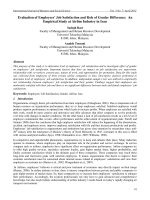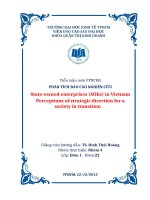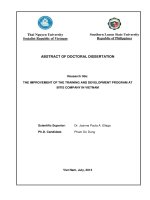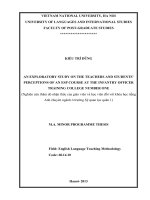Vietnamese EFL college students’ perceptions of listening comprehension problems a study at a university in vietnam
Bạn đang xem bản rút gọn của tài liệu. Xem và tải ngay bản đầy đủ của tài liệu tại đây (778.87 KB, 68 trang )
VIETNAM NATIONAL UNIVERSITY, HANOI
UNIVERSITY OF LANGUAGES AND INTERNATIONAL STUDIES
FACULTY OF POST- GRADUATE STUDIES
BÙI THÚY NGA
VIETNAMESE EFL COLLEGE STUDENTS’ PERCEPTIONS
OF LISTENING COMPREHENSION PROBLEMS:
A STUDY AT A UNIVERSITY IN VIETNAM
(Nhận thức của sinh viên học tiếng Anh về các vấn đề khi
ến An
n
n ứ
n đ
ọ
n
V
N
M.A MINOR THESIS
Field
: English Teaching Methodology
Code
: 8140231.01
Hanoi – 2021
VIETNAM NATIONAL UNIVERSITY, HANOI
UNIVERSITY OF LANGUAGES AND INTERNATIONAL STUDIES
FACULTY OF POST- GRADUATE STUDIES
BÙI THÚY NGA
VIETNAMESE EFL COLLEGE STUDENTS’ PERCEPTIONS
OF LISTENING COMPREHENSION PROBLEMS:
A STUDY AT A UNIVERSITY IN VIETNAM
(Nhận thức của sinh viên học tiếng Anh về các vấn đề khi
ến An
n
n ứ
n đ
ọ
n
V
N
M.A MINOR THESIS
Field
: English Teaching Methodology
Code
: 8140231.01
Supervisor : Assoc. Prof. Nguyen Thuy Nga
Hanoi – 2021
DECLARATION
This is to certify that this thesis is of my own research and has not been
submitted to any other university or institution degree or other purposes.
Except where the reference is indicated, no other person‟s work has been used
without due acknowledgement in text of the thesis. I certify that the assistance
received in preparing this thesis and sources have been acknowledged.
Hanoi, 2021
Bùi Thúy Nga.
i
ACKNOWLEDGEMENTS
This thesis could not have been completed without the help and support
from a number of people.
First and foremost, I would like to send my sincere thanks to my
supervisor, Assoc.Prof. Nguyễn Thúy Nga for her enthusiastic guidance,
insightful comments, and valuable support throughout my research.
I would also like to thank all of the lecturers of the Department of
Postgraduate Studies, Vietnam National University for their useful lectures
and materials which are of great value to my thesis.
A special word of thanks goes to all of my fellow master students for
their feedback, cooperation and of course friendship.
Last but not the least, I would like to thank my boyfriend and my
family for supporting me spiritually throughout writing this thesis and my life
in general.
ii
ABSTRACT
Listening skill is appreciated as a key skill in real-life communication
as well as language acquisition. Therefore, there have been numerous studies
of this skill in different aspects. This study attempts to investigate the
perceived problems Vietnamese EFL college students commonly encounter
when doing listening test and the relationship between these problems and
students‟ actual performance. Specifically, it involves the listening test scores
and responses on listening problems of 43 EFL learners at a college in Hanoi.
Descriptive statistics reveals that the listening problems faced by students are
mainly from context and input factors, followed by process and task factors.
However, as regression analysis points out, students‟ listening test scores
have rather strong association with two factors namely affect and listener
factors. Based on these findings, pedagogical implications for teaching and
learning listening skills are also discussed, such as planning listening lessons
with memory and concentration activities and providing and gaining
constructive feedback.
Key words: listening skills, listening problems, listening scores
iii
LIST OF ABBREVIATIONS
EFL
English as a Foreign Language
CEFR
Common European Framework of
References
IELTS
International English Language Testing
System
HaUI
Hanoi University of Industry
DLPT
Defense Language Proficiency Test
GEPT
General English Proficiency Test
L1
First Language / Mother Tongue
L2
Second Language
iv
LISTS OF FIGURES AND TABLES
Table 3.1. Structure of the listening test ......................................................... 25
Table 4.1. Overview of the listening comprehension problems ..................... 28
Table 4.2. Top five problems encountered in listening comprehension test .. 29
Table 4.3. Listening problems related to process factor ................................. 32
Table 4.4. Listening problems related to listener factor ................................. 36
Table 4.5. Correlation between listening scores and different factors............ 38
Table 4.6. Model Summary Table .................................................................. 40
Table 4.7. ANOVA Table (test using alpha = .05) ......................................... 40
Table 4.8. Coefficients Table (test each predictor at alpha = .05) .................. 42
Table 4.9. Summary of Coefficients Table (test each predictor at alpha = .05).....42
v
TABLE OF CONTENTS
DECLARATION .............................................................................................. i
ACKNOWLEDGEMENTS............................................................................ ii
ABSTRACT .................................................................................................... iii
LIST OF ABBREVIATIONS ....................................................................... iv
LISTS OF FIGURES AND TABLES............................................................ v
CHAPTER 1: INTRODUCTION ................................................................. 1
1. Rationale........................................................................................................ 1
2. Aims and objectives of the study .................................................................. 2
3. Research questions ........................................................................................ 2
4. Method and procedures ................................................................................. 3
5. Scope of the study ......................................................................................... 4
6. Significance of the study ............................................................................... 5
7. Structure of the thesis .................................................................................... 7
CHAPTER 2: THEORETICAL BACKGROUND AND LITERATURE
REVIEW .......................................................................................................... 9
2.1. Listening skill in English language teaching ............................................. 9
2.2 Listening comprehension .......................................................................... 10
2.2.1 Definitions of listening comprehension ................................................. 10
2.2.2 The importance of listening comprehension .......................................... 12
2.2.3 The process of listening comprehension ................................................ 13
2.3. EFL learners‟ listening problems ............................................................. 15
2.4 The correlation between EFL learners‟ listening comprehension problems
and their performance. .................................................................................... 18
2.4.1 Review of previous studies overseas ..................................................... 18
2.4.2 Review of previous studies in Vietnam ................................................. 20
2.5 Framework for investigating listening problems ...................................... 20
vi
CHAPTER 3: METHODOLOGY............................................................... 23
3.1. The setting of the study and participants ................................................. 23
3.2. Data collection instrument and procedure ............................................... 24
3.3. Data analysis methods .............................................................................. 26
CHAPTER 4: FINGDINGS ......................................................................... 28
4.1. Problems frequently encountered by students while listening................. 28
4.2. The relationship between listening problems and listening scores .......... 38
4.2.1. Interpretation of output from correlation analysis ................................ 38
4.2.2. Interpretation of output from multiple regression analysis ................... 39
CHAPTER 5: CONCLUSION ..................................................................... 45
5.1. Recapitulation .......................................................................................... 45
5.2. Implications .............................................................................................. 47
5.3. Limitations and suggestions for further studies ....................................... 48
REFERENCES .............................................................................................. 50
APPENDIX ....................................................................................................... I
vii
CHAPTER 1: INTRODUCTION
1. Rationale
Among four language skills, listening is believed to play a vital role in
developing foreign language competence. Nunan (1998) asserts that listening
is the basic skill in language learning and over 50% of the time is actually
spent on listening while learners are functioning in a foreign language.
Improvement in listening skill is also proved to have positive influence on the
other three language skills (Pearson & Fielding, 1991), thus need to gain more
attention in EFL classroom.
Despite being considered the most challenging skill to teach and learn
(Field, 2008), listening skill is by far the least widely researched among the
four language skills (Plonsky, 2011). Compared to the other receptive skill,
listening to a foreign language is understudied, since its process is more
difficult to observed and manipulated than reading skills (Osada, 2004). In
English language teaching process, grammar, reading and vocabulary appear
to gain more attention than listening skill. The fact that it is neglected in
teaching curricula, textbooks and teachers‟ lesson planning probably lead to
serious problems that many EFL learners are exposed to in listening
comprehension tasks (Gilakjani & Ahmadi, 2011).
This same issue can also be found in Vietnam, where English is
introduced to learners since third grade of primary school, and upon finishing
secondary education (a.k.a. lower-secondary and higher-secondary schools),
students are expected to achieve B1 level of the Common European
Framework of References for languages (CEFR), according to National
Foreign Languages 2020 Project which has come into effect since 2008.
However, this expectation is hardly met and when moving to post-secondary
1
education, English learners, especially non-English major students still have
various problems with language skills, especially speaking and listening.
Since the English college entrance exam only tests students‟ vocabulary and
grammar knowledge as well as reading and writing skills, the washback effect
of teaching to testing has made English education in Vietnam to neglect
speaking and listening skills. That is why together with speaking, listening is
the most difficult skill for EFL college students. The struggles they have can
be clearly observed by their scores on listening comprehension test.
Therefore, it is vital for teachers to find out the students‟ difficulties with this
skill and finally help them to improve their performance in listening tests.
In spite of the significant role of the research matter, the investigation
of listening problems faced by Vietnamese EFL students has not been found
adequately. Therefore, this study was designed to make an effort to discover
EFL college students‟ listening problems and to determine whether a
relationship exists between their problems and listening test performance.
2. Aims and objectives of the study
The researcher aims to give a closer investigation into listening
comprehension problems and possible strategies to tackle those difficulties. In
detail, the objectives are as follows.
Identifying what problems are met by Vietnamese EFL college
students when doing listening comprehension practice and tests.
Finding out whether there exists a relationship between their
problems and their actual listening test scores.
3. Research questions
With the stated premises, this study is designed to examine these
questions from the perspectives of the teachers:
1. What are the problems that Vietnamese EFL college students face
when doing listening comprehension test?
2
2. Is there any relationship between their problems and their actual
listening test scores? If so, which factor(s) affect their performance?
4. Method and procedures
To fulfill the above aims, the study was conducted with quantitative
methods of data collection and correlational analysis. The instruments used in
this study were: (1) a listening comprehension test, (2) a questionnaire with
the subjects.
Firstly, participants were required to sit a listening comprehension test
consisting of 3 parts, which had been adapted from Section 2, 3, and 4 of
IELTS Listening test materials. The test aimed at English proficiency level of
B2 in the Common European Framework of Reference for Languages
(CEFR). Secondly, students were required to fill in the questionnaire
comprising two parts: personal information and listening problems. This
questionnaire was used to get information about the difficulties the students
were facing in EFL listening while taking listening course and listening tests
at Hanoi University of Industry. Afterwards, a proportion of participants were
encouraged to take part in a session of a semi-structured interview. The
follow-up interview‟s sole purpose was to double-check the information that
was obtained through the questionnaire. Therefore, the semi-structured
interview was not considered one of the main instruments used for this study.
The two main instruments, namely, the test and the questionnaire, were
described in more details in Chapter 3: Methodology.
After obtained from the listening comprehension test and the
questionnaire, data was analyzed quantitatively. For the first research
question, descriptive statistics with mean and standard deviation are employed
to identify the major problems faced by students in the listening
comprehension test.
3
With regards to the second research question, correlation analysis was
first applied in order to see whether the relationship between these perceived
problems and students‟ listening scores existed. The researcher went on to
carry out regression analysis to investigate the relationship between each of
the six factors (process, input, listener, task, affect, context) and students‟
performance. This was for the purpose of finding out how much the
difficulties faced by students affect their listening score.
5. Scope of the study
The study was carried out at Hanoi University of Industry (HaUI), an
accredited technical university. Although this university‟s major departments
are associated with industry, technology and applied science; it also caters for
those who major in business and foreign languages as well. The participants
in this study were 43 undergraduate students in the department of English
language and translation who are now at their 5th semester. Their age ranges
from 19-22 years old.
All of them were attending the course called Listening-Speaking 5 at
the time the study was conducted, and were chosen using convenient
sampling. The language courses offered to them include a listening
component. By participating in listening courses available, they were
provided plenty of opportunities to listen to a variety of spoken language,
namely, daily conversations, short talks, presentations and lectures in English.
This study aims at determining the problems faced by English-major
students at Hanoi University of Industry when they are doing listening
comprehension tasks. The scope of the study is limited to this specific group
of students, and thus, the results might be more valuable to the internal
revision within the institution itself of their teaching and assessment
materials.
4
6. Significance of the study
This study was conducted to find out the problems encountered by EFL
college students when listening comprehension tasks are being conducted;
hence, practically, it was expected to be a useful reference material to teachers
who are currently teaching the course Listening-Speaking 5 at Hanoi
University of Industry, as well as teachers who are in charge of similar
English courses in other educational institutions.
Besides being of immediate use to teachers of English at Faculty of
Foreign Languages at HaUI, theoretically, this study might also interest those
whose academic work are focusing on the listening component in the field of
English Language Teaching.
To be more specific, recognition of the factors that are the roots of the
problems that EFL learners were facing in their study process would benefit
the following groups:
EFL teachers at Hanoi University of Industry: to be provided
with insights of their students‟ difficulties that occur when they
are doing listening comprehension tasks, and reflect on their own
teaching and assessing methods to enhance their students‟
performance. Knowing the occurrence of those identified
problems would inherently help teachers stand a higher chance in
guiding their learners so that they can tackle the listening
difficulties they are experiencing. It is also hoped that the
findings of this research paper can provide English language
teachers at Hanoi University of Industry with some guidelines
for material evaluation, selection and adaptation. Besides, the
results of the study might be able to propose some indications for
EFL teachers at HaUI to revisit and/or revise their teaching and
5
assessment materials. In addition, thanks to this study, other
teachers of English at University of Industry might be aspired to
produce similar research into other groups of students apart from
English-major students at the very same institution.
EFL teachers of similar language courses at other educational
institutions in Hanoi: to be inspired to propose similar research
questions and conduct investigation into the problems faced by
their own students‟ body when they are taking listening
comprehension tests. Being equipped with this knowledge, they
may find ways to improve their own teaching methods or
assessment materials.
EFL learners at HaUI: to identify the listening comprehension
challenges that they are having, so that they may come up with, on
their own or with the help of their teacher or mentor, what further
learning strategies are needed for them to achieve progress in
listening skill acquisition. One way or another, learners ought to be
aware of the factors which might be responsible for their listening
problems. When listeners have a certain amount of knowledge of
their own challenges, they are likely to be able to grow to become
better listeners as well as more well-rounded learners.
Researchers who have taken an interest in EFL learning and
teaching: to use the findings as a basis for a similar study at other
institutions or with another group of students, for further study of
the similar topic or a reference material in their own paper.
All in all, the researcher believes the thesis will be helpful in practice to
all stakeholders in Faculty of Foreign Languages at Hanoi University of
6
Industry; and theoretically, it might be useful for scholars who are researching
into English as a Foreign Language Teaching field.
7. Structure of the thesis
This research consists of five chapters:
Chapter 1: Introduction
It is important, first and foremost, to state the reasons, objectives, and
values of the research. Consequently, the Introduction involves seven
sections: Rationale, Research goals, Research questions, Research scope,
Research instruments and procedures, Research significance, and Design of
the research.
Chapter 2: Theoretical background and literature review
This includes the explanation of key definitions of listening
comprehension and listening comprehension problems. Moreover, it presents
the review on different previous works on listening comprehension skill and
listening comprehension problems to point out the research gaps.
Chapter 3: Methodology
This chapter presents research methodology, the setting of the study
and participants, and data collection instruments and procedures.
Chapter 4: Findings
This chapter states what can be learned during the research and
interprets the results. This chapter presents the findings of the data analysis as
following:
4.1. Problems frequently encountered by students while listening
4.2. The relationship between listening problems and listening scores
Chapter 5: Conclusions
In this chapter, the conclusions of the paper will be presented. This part
also summarizes how to conduct the research to the objectives, and offers
7
possible
guidelines
Recapitulation,
for
future
Concluding
research.
remarks,
Recommendations for further study.
8
Five
parts
Implications,
are
included:
Limitations,
and
CHAPTER 2: THEORETICAL BACKGROUND AND
LITERATURE REVIEW
2.1. Listening skill in English language teaching
In the field of EFL acquisition, listening plays a significant role, since it
is the most regularly used language skill in the classroom (Ferris, 1998;
Nunan, 1998) and it takes a crucial part in improving EFL learners‟ language
competence. Dunkel (1991) and Feyten (1991) both agree that listening can
provide meaningful input for the learner, which is the fundamental foundation
for any learning. Rost (2006) also supports this idea by stating that listening
provides the linguistic environment and sets the stage for acquisition.
Therefore, good competence in listening comprehension can have great
impact on improving the other three language skills (Pearson & Fielding,
1991). In addition, acquiring listening skill also facilitates students to get
access to various information sources in the age of blooming technology and
multimedia, such as online audios and videos, podcasts and vlogs.
Simply speaking, listening can be defined as “the activity of paying
attention to and trying to get the meaning of something we hear”
(Underwood, 1989, p.1). A more elaborate definition of listening is proposed
by O‟Malley, Chamot and Kupper (1989): “listening comprehension is an
active and conscious process in which the listener constructs meaning by
using cues from contextual information and from existing knowledge, while
relying upon multiple strategic resources to fulfill the task requirement”
(p.19). Sharing the same view that listening is mostly associated with the
ability to understand speaker‟s meaning, Mendelson (1994) adds that the
required abilities of a competent listener are processing the linguistics forms,
interacting, understand the message and decipher the speaker‟s intention.
Later, Steinberg (2007) emphasizes the need of distinguishing listening from
9
hearing, asserting that listening is a complex process involving four distinct
stages: sensing and attending, understanding and interpreting, remembering
and responding.
Although the fact that EFL leaners only sit quietly when doing listening
comprehension creates the impression of listening as a passive skill, it is
actually argued by most scholars to be an active and dynamic process. Purdy
(1997) clarified such process engaged in listening: “attending, perceiving,
interpreting, remembering, and responding to the expressed (verbal and
nonverbal), needs, concerns, and information offered by other human beings”
(p. 8). Rost (2002) proposed the idea of listening comprehension as an
inferential process, in which listener‟s main jobs are constructing, decoding
and negotiating meanings with the speaker. The ability to understand and
interpret spoken messages in real time is attributed to the process of
integrating information from phonetic, phonological, prosodic, syntactic,
semantic and pragmatic sources (Lynch, 1998); therefore, listening can be
regarded an active and complex process which requires both linguistic and
world knowledge. In order to achieve comprehension, bottom-up (datadriven) and top-down (conceptually-driven) are the two processes common
applied (Nunan, 1998). While the bottom-up allows listeners to form the
meaning basing on linguistic cues in speakers‟ utterances, top-down process
mainly depends on background knowledge in interpreting what listeners hear.
In a nutshell, it is widely agreed that rather than a solely passive
reception of audible signs, listening comprehension is an active, complex and
interactive process involving different cognitive strategies and stages.
2.2 Listening comprehension
2.2.1 Definitions of listening comprehension
A number of definitions of listening comprehension skill have been put
forward and each of those definitions reflects its author's own point of view.
The following are some representative definitions of listening comprehension.
10
Buck (2001: 31) defined listening comprehension as an active process
in which listeners are involved in constructing meaning. He emphasizes that
both linguistic knowledge and non-linguistic knowledge are used for the
understanding of incoming speech by listeners. It can be realized from this
definition that listening comprehension is more than hearing because listeners
actively interpret what speakers say basing on their linguistic and nonlinguistic knowledge.
Rost (2002: 3) considered listening comprehension as a cognitive
process to represent and form meaning from what speakers say. According to
him, meaning 8 construction is assisted by contextual factors. Moreover,
listening comprehension involves establishing a negotiation in meaning (with
the speaker), and giving responses. Thus, listening comprehension is one
integral part of communication skill in which context plays an important role
in identifying speakers' intention.
Jeon (2007: 50) stated that listening comprehension requires listeners'
capacity to "apprehend, recognize, discriminate, or even ignore certain
information". He also pointed out the factors which are necessary for listening
comprehension: linguistic knowledge, personal expectation, cognitive
processing skills, world knowledge and prior experience which listeners have.
Thus, listening comprehension depends on a variety of listeners' sub-skills,
knowledge, and experience.
Nadig (2013: l743) simply defined listening comprehension as the
various processes of interpreting spoken language. According to him, the
processes are based on listeners' perception of speech sounds, comprehension
of the meaning of individual words and the syntax of sentences.
It can be concluded from the definitions mentioned above that
“listening comprehension is an active and purposeful process” in which
11
listeners try to interpret speakers' intention and respond. In other words,
listening is an important skill in communication. It may include interrelated
activities such as receiving aural stimuli, attaching meaning to aural symbols,
remembering and responding to oral communication. The factors which are
necessary for listening comprehension are linguistic knowledge. personal
expectation, cognitive processing skills, and world knowledge.
2.2.2 The importance of listening comprehension
Before 1960s, the role of listening comprehension in language learning
was taken for granted, so teaching of listening comprehension was completely
neglected. Nevertheless, with a new wave of interest in the development of
communicative competence in language teaching, there came an increasing
awareness of the significant role of listening. Through a great number of
researches, listening comprehension has been proved to play a very crucial
role in human being's communication, language learning, and second
language acquisition.
Devine‟s (1982:7) definition of listening comprehension was that,
“listening is the primary means by which incoming ideas and information are
taken in". Thus, it is obvious that listening is a receptive skill and an integral
part of human being's communication. Furthermore, listening is the skill used
most frequently in verbal communication. In general, successful listening may
involve successful communication.
Hasan (2000: 138), in addition to this, mentioned multiple times in his
works that “listening comprehension provides the right conditions for
language acquisition and the development of other language skills”. The
proficiency in speaking and pronunciation can only be perfectly achieved
through listening skill.
12
All in all, the significant role of listening comprehension skill in human
being's communication, language learning. and second language acquisition is
undeniable. This is the reason why teaching and learning listening
comprehension skill have received more and more attention of researchers,
teachers, and learners over the world.
2.2.3 The process of listening comprehension
Prior to 1960s, listening comprehension is labeled as a passive skill.
However, this opinion has changed since 1980s. Listening comprehension is
considered as “an active and complex process” which is illustrated by
Anderson's model.
Anderson
(1995)
divided
listening
comprehension
into
three
interrelated cognitive processes: perception, parsing and utilization. In terms
of the first process, perceptual processing is “the encoding of the acoustic or
written message”. In particular, a person pays close attention to input and the
sounds are stored in echoic memory. Simultaneously, some initial analysis of
the language code may start, and encoding processes may transform some of
the input into meaningful representations. In the second process - parsing,
words are converted into a mental representation of the combined meaning of
those words which “can be stored in short- term memory”. The basic unit of
the process is a proposition. The third process, utilization, involves the
process of “associating a mental representation of the auditory meaning with
existing knowledge” to form schemata whose role is guiding the
comprehension process. If the input is compatible with the schema, meaning
the listener has managed to successfully comprehend the text. By contrast,
“either the information or the schema will be discarded or modified”.
Anderson‟s model (1995) suggested that the first two steps belong to
bottom-up process, meanwhile the third step is of top-down process. Those
13
two processes are described in details as followed.
Bottom-up processing which is suitable to the way of thinking of
almost people takes place in a definite order from the lowest level to the
highest level. In particular, phonemic units are first decoded and connected to
form words; words then are linked together to construct phrases; afterwards,
phrases are put together to build up utterances; and last, utterances are
combined to create a complete, meaningful text. This process is closely
associated with the listeners' linguistic knowledge. In fact, the processing of
different types of knowledge does not occur in a fixed sequence. It is quite
possible to understand the meaning of a word before decoding its sounds
thanks to the knowledge of the world around us and our expectation to
incoming information.
Top-down processing is defined as using background knowledge in
comprehending the meaning of a message. The listener has to call for their
own prior knowledge of the topic, context and situation of the occurrence of
the audio they are listening to. In this case, context and situation include
things such as topic knowledge that listeners have already known in their own
experience or exposure, who the speakers are, their correlation with the
situation, their relationships with each other and the relationships between the
events at hand and the previous events. However, if the data the listener takes
in though the process of listening is unfamiliar to his own knowledge, it
cannot evoke his schemata and it is mandatory for him to largely rely on his
linguistic knowledge in order to comprehend the task at hand. Additionally,
even though in the cases when the listener does trigger a schema, he might not
have the compatible schema expected by the speaker(s). As a result, only
depending on top-down processing can be likely to lead to a failure of
comprehension.
14
To conclude, it is undeniable that both bottom-up process and top-down
process have downsides. This is the reason why another model which is
interactive process is proposed. When the content of the material is familiar to
the listener, he will employ his background knowledge to make predictions
which will be proved by the new input. By contrast, if the listener is
unfamiliar with the content of the listening text, he can only depend on his
linguistic knowledge, especially the lexical and syntactical knowledge to
make sense of the information.
In summary, listening comprehension is a very complex process in
which both bottom-up and top-down process play a crucial part. The
researcher is quite in favor of the opinion that listening comprehension is an
interactive process.
2.3. EFL
n s’ s n n p o
s
Due to the complexity of different cognitive stages involved in
listening comprehension, EFL learners usually need to make remarkable
processing efforts when they listen, which makes listening the most difficult
skill of all (Graham, 2006). Especially in listening to a recorded text, where
listeners are not offered the chance to interact with the speakers to negotiate
for meaning, EFL learners frequently have much greater difficulties since
they have no control over the speech rate, manner and content. As Flowerdew
(1994) point out, listening requires real-time processing without the chance to
go back to the sections that just have been missed; and some aurally presented
materials like phonological and lexical features may not be present in written
materials. These two distinct characteristics of listening comprehension have
posed a number of obstacles for EFL learners.
It is a view held widely by many researchers and teachers of English
that listening is an intricate cognitive process that are associated with
15
„perception‟, „attention‟, „cognition‟ and „memory‟. The ability to listen of
students of English may be affected by a diversity of factors. Hayati (2010)
and Flowerdew and Miller (1992) have drafted out several lists of general
factors as well as specific factors. To take some examples, research has been
looking closely into speech rate (Conrad, 1989; Blau, 1990; Griffths, 1992;
Zhao, 1997), lexis (Rost, 1992), phonological features and background
knowledge (Long, 1990; Chiang and Dunkel, 1992). In addition, there are
some other issues that might have a causal relationship with listener‟
difficulties, such as text structure and syntax or personal factors. To
exemplify the latter, insufficient exposure to the target language, a.k.a.
English in this case, and lack of interest or motivation can be taken into
consideration.
All the aforementioned factors are acknowledged by Brown (1995).
Another contribution, as Brown (1995) further added, to listener‟s
difficulties is “the levels of cognitive demands made by the content of the
texts.” Before that, a wide variety of problems that EFL learners have to
face in listening comprehension had been mentioned and discussed in
literature (Underwood, 1989; Ur, 1984). In addition, other challenges such
as unfamiliar vocabulary items, topics, and accents, and fast speech rate
were later identified by Buck (2001).
In 1997, Higgins investigated into listening comprehension hardships
of students in Oman and the results showed that speech rate, vocabulary and
pronunciation are the three factors that can either facilitate or block listening
comprehension. Afterwards, in 2000, a study carried out by Hasan examined
the perceived listening comprehension obstacles through 81 EFL Arabic
speakers and pointed out that the most important message factors were
„unfamiliar words‟, „difficult grammatical structures‟, and „the length of the
16









